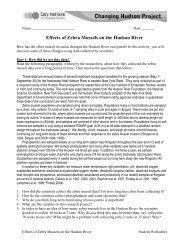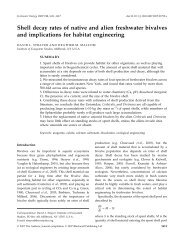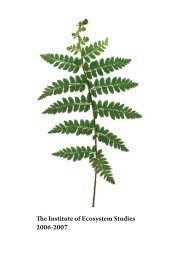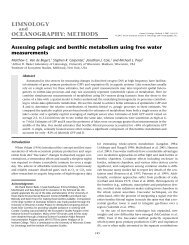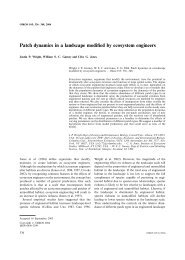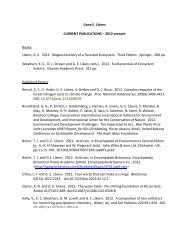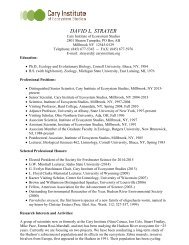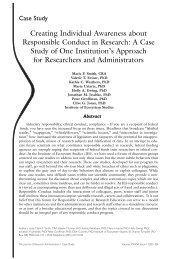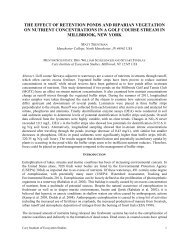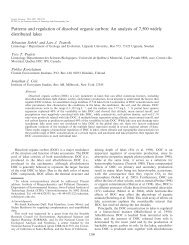Designed experiments: new approaches to studying urban ...
Designed experiments: new approaches to studying urban ...
Designed experiments: new approaches to studying urban ...
You also want an ePaper? Increase the reach of your titles
YUMPU automatically turns print PDFs into web optimized ePapers that Google loves.
AJ Felson and STA Pickett<strong>Designed</strong> <strong>experiments</strong> in <strong>urban</strong> ecosystemscreating aesthetically pleasing amenities and enhancing<strong>urban</strong> space. For designers, the approach could provide a<strong>new</strong> design paradigm that builds on past movements,including modernism or the picturesque. Infusing educationaland aesthetic qualities in<strong>to</strong> <strong>urban</strong> experimentationwill raise its public value and help bring identity <strong>to</strong> otherwiseoften inconspicuous research sites.Play a useful role in the citySuch <strong>experiments</strong> would create design solutions thatadapt <strong>to</strong> site context and constraints, and address themultifaceted conditions of cities. They would function aspart of the city fabric, for example by improving safety,facilitating circulation, and creating park spaces. In thisway they would play a social or functional role, thusbecoming a conspicuous and lasting part of the city.Allow research in multiple locationsChanneling <strong>experiments</strong> through <strong>urban</strong> design projects willhelp spread research sites throughout the city. Exploitingthe range of conditions available in the metropolis isalready one of the goals that ecologists recognize throughsuch <strong>approaches</strong> as <strong>urban</strong>–rural gradients (McDonnell andPickett 1993; Table 1). <strong>Designed</strong> <strong>experiments</strong> take this furtherby making all designed buildings, infrastructure andlandscapes accessible as potential sites for experimentation.Provide a public identity for <strong>urban</strong> ecologyInserting simple experimental units in<strong>to</strong> multiple researchsites would help produce a set of common experimentaldesigns that become recognizable figures in everyday landscapes.These informational, functional, and aestheticadditions <strong>to</strong> the city should foster public appreciation andunderstanding. This, in turn, could help <strong>to</strong> reduce vandalism,encourage public participation in sustaining andmaintaining the <strong>experiments</strong>, and increase demand forsimilar <strong>experiments</strong> elsewhere. Public involvement mayalso be essential for tackling obstacles such as highly fragmentedprivate land ownership or regula<strong>to</strong>ry controls.Reintegrate ecological processes in<strong>to</strong> cities<strong>Designed</strong> <strong>experiments</strong> could reintroduce biological activity,such as enhanced vegetative structure, increased soilmicrobial activity, or improved riparian function, <strong>to</strong> <strong>urban</strong>areas. This infusion of ecological functions in<strong>to</strong> <strong>urban</strong>design practices, could ultimately result in a “retrofitting”of <strong>urban</strong> environments <strong>to</strong> include more biologically diversesystems and <strong>to</strong> better accommodate ecological functions. Conclusions<strong>Designed</strong> <strong>experiments</strong> are a potential means for ecologists<strong>to</strong> investigate <strong>urban</strong> ecology collaboratively with architects,landscape architects, and <strong>urban</strong> designers. Thisinterdisciplinary effort raises the potential for ecologists<strong>to</strong> become involved in the actual design process of <strong>urban</strong>areas. This allows the infusion of experimental goals andmoni<strong>to</strong>ring <strong>approaches</strong> in<strong>to</strong> the projects. Such <strong>experiments</strong>would take advantage of designed <strong>urban</strong> components,including buildings, streetscapes, parks, and infrastructure,<strong>to</strong> establish further research sites. Functioningboth for research and <strong>urban</strong> design, <strong>experiments</strong> willblend quantitative analysis with aesthetics and function,providing a cultural identity for experimental research,creating usable spaces for people, and contributing <strong>to</strong><strong>urban</strong> evolution. Through the effort of creating and then<strong>studying</strong> these spaces, ecologists will accumulate quantitativedata, which can then be fed back in<strong>to</strong> <strong>new</strong> experimentaldesign proposals. Over time, designed <strong>experiments</strong>have the potential <strong>to</strong> deepen our understanding ofhuman impacts on biological processes and <strong>to</strong> improvethe ecological function of human-dominated landscapes.<strong>Designed</strong> <strong>experiments</strong> expand traditional ecologicalgoals <strong>to</strong> include the <strong>new</strong> role of <strong>urban</strong> place-making.Merging ecology with design will help engage ecologists inattempts <strong>to</strong> structure and maintain <strong>urban</strong> environments.Focusing on the creation of <strong>urban</strong> ecological forms thatintegrate traditional research with the functional and aestheticdesign of <strong>urban</strong> space, ecologists will contribute <strong>to</strong><strong>urban</strong> processes and growth. As in adaptive managementused in forests and fisheries (Likens et al. 1995; Holling etal. 1996), <strong>urban</strong> ecologists could use designed <strong>experiments</strong>as a management <strong>to</strong>ol <strong>to</strong> predict, moni<strong>to</strong>r, and regulate<strong>urban</strong> ecological patterns and processes. Through a crossdisciplinaryexchange, these experimental strategieswould help place research within cultural, aesthetic, informational,and functional <strong>urban</strong> networks. AcknowledgementsThis paper is a contribution <strong>to</strong> the Baltimore EcosystemStudy, LTER (NSF DEB 9714835), and <strong>to</strong> the program ofthe Institute of Ecosystem Studies, with partial supportfrom the Mary Flagler Cary Charitable Trust. ReferencesAlberti M, Marzluff JM, Shulenberger E, et al. 2003. Integratinghumans in<strong>to</strong> ecology: opportunities and challenges for <strong>studying</strong><strong>urban</strong> ecosystems. Bioscience 53: 1169–79.Amidon J. 2005. Ken Smith Landscape Architect: <strong>urban</strong> projects.Prince<strong>to</strong>n, NJ: Prince<strong>to</strong>n Architectural Press.Bacon EN. 1967. Design of cities. New York, NY: Viking Press.Banham R. 1960. Theory and design in the first machine age.Cambridge, MA: MIT Press.Beardsley J. 1984. Earthworks and beyond: contemporary art in thelandscape. New York, NY: Abbeville Press.Berkowitz A, Nilon CH, and Hollweg KS (Eds). 2003.Understanding <strong>urban</strong> ecosystems: a <strong>new</strong> frontier for scienceand education. New York, NY: Springer-Verlag.Bradshaw AD and Chadwick MJ. 1980. The res<strong>to</strong>ration of land:the ecology and reclamation of derelict and degraded land.Berkeley, CA: University of California Press.Calthorpe P. 1995. The next American metropolis: ecology, com-555© The Ecological Society of America www.frontiersinecology.org



